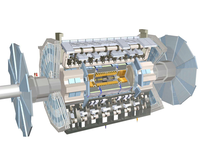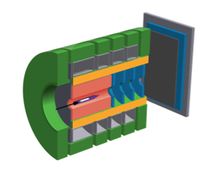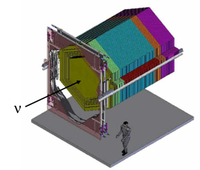Summary
I am an experimental physicist, performing experiments at three international accelerator laboratories - CERN, Jefferson Lab, and Fermilab. In many of my activities I am exploring the propagation of partons (~quarks and gluons) through strongly interacting systems. I also have worked on measurements of the neutron elastic form factor and of the two-photon exchange component of elastic scattering of electrons on protons.
CERN
At CERN I am a member of the ATLAS collaboration, performing experiments at the Large Hadron Collider. Formerly I was a member of the RD-51 R&D collaboration and the NA-61 experiment at CERN. I am active in the Heavy Ion Physics working group of ATLAS, and was a co-convenor of this group from 2010-2012. My present research focus in this group is on pT broadening of J/ψ mesons as a measure of gluon pT broadening in cold nuclear matter, which is a probe of gluon saturation. I am also interested in heavy quark energy loss as revealed by J/ψ mesons with detached vertices in collisions involving nuclei, particularly in hot nuclear matter.
Jefferson Lab
At Jefferson Lab I work in two collaborations for fixed-target experiments, one based in Hall B (the CLAS Collaboration) and one based in Hall D (the GlueX Collaboration). Jefferson Lab is completing an upgrade, called the "12 GeV Upgrade," which increases the maximum energy of the electron beam from 6 GeV to 12 GeV, adds new experimental equipment to the existing experimental halls, and adds a new hall, Hall D, for polarized photon beam experiments. I am a spokesperson for 3 experiments with a 6 GeV beam, and for 3 experiments with the future 12 GeV beam. Parton propagation is a focus of one 6 GeV experiment (E-02-104) and one 12 GeV experiment (E12-06-117).
Fermilab
At Fermilab I work in the MINERVA collaboration. To date I am mostly finding new young people to work on the experiment, rather than pursuing physics measurements myself. However, in the long term I am interested in applying the principles of hadron formation physics to final state hadrons in neutrino-nucleus interactions. The lessons we learn about hadron attenuation in electron-nucleus deep inelastic scattering interactions should be applicable for neutrino beams, and should play a very important role in interpreting the data when final-state hadrons are involved.
Links to papers and citations:
Color propagation: why is it so interesting?
Very briefly, of the three known fundamental forces, the "strong" force is the most peculiar. In very energetic collisions involving systems of quarks and gluons at small distance scales ("perturbative kinematics"), it is well described by the theory called Quantum Chromodynamics, or QCD. We believe QCD also describes all the other types of strong interactions too ("non-perturbative kinematics"), but so far this has been much more difficult to prove because we don't yet know how to solve the relevant equations. Perhaps the most striking feature of non-perturbative kinematics is the feature called "confinement." Quarks and gluons carry "color charge," an analog to the familiar electrical charge. The confinement principle dictates that systems of quarks and gluons must have neutral color charge overall, just as an atom has neutral electrical charge overall. Unlike an atom, however, there is no analog to a stable ion in QCD, i.e., no strongly interacting object can carry net color charge except for very brief time intervals. Even in extremely energetic interactions where thousands of colored particles are produced in an explosive spray, by the time they travel more than a few hundred femtometers they condense into color neutral combinations, finding partners and forming into systems of two and three quarks, and gathering up all the charged gluons as well to 'glue' the quarks together. How does this happen? It is an enigma, a mystery; although some models succeed in describing several features of the data, they cannot be derived from the fundamental QCD theory, and no single model can describe all the relevant data. Together with my colleagues, I am trying to discover the mechanisms for this dynamical enforcement of confinement by using atomic nuclei as spatial analyzers of this process in which only color-neutral particles emerge out of highly colorful systems. This process is called "hadronization" or "fragmentation." The early stages of the process leading to hadronization involves propagation of a quasi-free parton, such as a quark. This parton loses energy through gluon emission as it propagates, even in the vacuum; if it propagates through a strongly-interacting medium, it loses even more energy through medium-stimulated gluon emission. The latter process is called 'partonic energy loss' and it has been studied in several experimental contexts - in semi-inclusive deep inelastic scattering, via the Drell-Yan process in hadron-nucleus scattering, and in heavy ion collisions. I find it particularly fascinating to find the same basic phenomena in such a diverse collection of very different types of experiments.




